Touted as one of the riskiest dogs to bring home, the Russian Bear Dog, commonly known as the Caucasian Shepherd or Caucasian Mountain dog, is a historic protector, a devoted guardian; yet calm and gentle with his flock.
This gentle giant stands up to 30” in height and can weigh in at up to 170lbs; similar to the Kangal Guardian Dog in size.
A huge bear which was bred to take down wolves and protect his flock. Think you have what it takes to care for one of these impressive dogs on a day to day basis? Let’s take a look at this dog in more detail.
| Breed Type | Working Dog |
| Purpose | Guardian and Companion |
| Suitable For | Families with experience of large breeds in large rural homes with a secured yard |
| Size | 23-30” in height – females are generally shorter |
| Weight | 100-170lbs – females are generally lighter |
| Lifespan | 10–12 years |
| Color Variations | Any solid color, piebald or spotted except for black |
| Temperament | Independent, aloof, bold, fearless, self-confident and wholeheartedly devoted |
| Activity Levels | Upwards of 60 minutes per day |
| Daily Food Consumption | In general, 20 calories per lb of body weight per day |
| Known Health Issues | Generally healthy, but there is a risk of hip dysplasia and eye issues |
TABLE OF CONTENTS
Russian Bear Dog Breed Overview
Renowned for being a protector, the Russian Bear Dog, is often described as an unpredictable attacker, however, this could not be further from the truth.
They are classified as a working dog, with the correct socialization and training, experienced handlers couldn’t want a more devoted family dog.
They can be aloof and wary with strangers, but who says dogs have to love everyone?
Russian Bear Dog Puppy
You can expect to pay between $1000 and $2000 for a Russian Bear Dog puppy. This premium helps ensure these beautiful and fearless dogs get into the right hands and when sourced from a reputable breeder.
So where does the Russian Bear Dog Breed originate from?
Originating in the Kavkaz (Caucasus) mountain range in Eastern Europe, along with several other mountain dog breeds, the Caucasian Shepherd (Caucasian mountain dog) as its name suggests was used to protect herds, flocks and dwellings from threats and predators.
Most commonly, to protect from wolves, legends are told of the Russian Bear Dog Temperament for protectiveness and faithfulness.
It is thought that dogs of similar type date back to ancient times, but this breed only seemed to be noticed across Europe during the 1920’s.
Its ferocity was noticed by the former Soviet Government who subsequently used these impeccable dogs to protect factories and government facilities.
It’s not clear when this dog first arrived in the US, but the United Kennel Club first registered them as a breed in 1995.
Frequently Asked Questions
- Russian Bear Dog Lifespan? From 10 to 12 years.
- Russian Bear Dogs Full Grown? Between 23-30” in height at the withers.
- Russian Bear Dogs Weight? Between 100 – 170lbs, and like most dog breeds, females are generally smaller.
- Russian Bear Dogs Price? You can expect to pay between $1,000 – $2,000.
Russian Bear Dog Temperament
Unlike designer dogs, who are well suited to city living, these guardians thrive in rural homes with a secured yard to play in. Russian Bear Dogs historically wandered properties and territories which makes them perfect walking or hiking buddies when fully matured.Naturally aloof and wary of strangers, the self-confident Russian Bear Dog is a fearless protector. He is calm and devoted to his family, with a personality that will melt your heart.
Once they’ve had their daily walks, they are relatively low energy, which means they will happily fit in with your daily errand running.
Not known for excessive barking, these powerful protectors will alert owners to any potential threats. They don’t take kindly to strangers in the home, so introducing new people needs time and patience.
Owners should be mindful of their history protecting flocks and herds from potential threats which were often other animals.
If socialized from a puppy, these Bears can tolerate other pets in the home, but again this needs an experienced owner to manage.
Caucasian Shepherds are intelligent, alert and independent. Not for first time owners or those with little experience of canine behavior. These majestic bears haven’t forgotten they would spend hours alone patrolling.
They can pose a challenge to train, but it’s not impossible. Socialization from a young age is essential if you are to stand any chance of him accepting those outside of your family.
Aloof and independent, but, a devoted family member, still think you have the experience to raise one of these powerful dogs? Let’s see what this looks like on a day to day basis.
How to Care for a Russian Bear Dog
As we’ve mentioned, the Russian Bear Dog is not for the fainthearted. He is best suited to rural locations, with a large house and secured yard to roam around in.
Experienced handlers are a must, to understand his history and his little nuances.
Food and Dietary Requirements
Like most large breed dogs, the Caucasian Shepherd is at risk of bloat. For this reason, puppy meals are best served 4 times per day; once fully matured, this can reduce to 2 meals per day.
A good quality food is a must, whether this is dry, wet, raw or dehydrated. Speak with a veterinarian or dietician if you are unsure of what to feed your dog.
Ensure you are meeting his protein requirements and not over-feeding during development. We know that over-feeding and excessive protein levels during skeletal development can be detrimental. As a puppy, a Russian Bear Dog, should be eating between 9.7g and 12.5g of protein per kg of body weight per day.
When fully grown this will reduce to 2.62g per kg of body weight per day.
On average, these gentle giants will eat around 20 calories per pound of body weight per day. So if your guy is weighing in at 140lbs, he will eat around 2,800 calories per day. This does vary depending on activity level, climate and age.
Russian Bear Dogs can easily put weight on so keep an eye on this. Through his long, thick coat you should be able to feel his ribs and also a waistline.
If you are regularly feeding healthy fruit treats to your dog, swap out some of his daily food allowance to accommodate for these.
Another way to monitor his weight is to ensure he stays active.
Exercising a Russian Bear Dog
As your Russian Bear Dog puppy is growing, you should limit their exercise to 5 minutes per month of age.
As an example
A five month old puppy should only be walking or exercising for 25 minutes at a time.
We know that over-exercising can be detrimental to your dog’s skeletal development, it can put unnecessary strain on their joints and bones.
You should also avoid letting any giant breed dog jump in and out of cars or climbing stairs until they are fully matured (typically two years). All of these movements, when growing, can contribute to the development of hip and elbow dysplasia; which is commonly found in giant breeds like King Shepherds.
One study examined 446 Caucasian Shepherds and found that 23% of these dogs showed clinical signs of hip dysplasia.
These impressive guardians are best suited to rural living, with plenty of space and an enclosed yard to roam.
When you do head out for walks, it’s best to keep them on leash as their size can be quite intimidating to others.
Training a Russian Bear Dog
Like all dogs, these Bears respond best to positive reinforcement and reward based training. Start young, make the training sessions short and positive.
Dog’s learn through operant conditioning meaning they will learn a behavior based on it’s consequence – a positive consequence (praise, reward etc) will mean they are more likely to repeat that behavior.
When your dog is behaving how you would like him to, praise and reward him. Due to their independent nature you will need to find out which rewards he places high value on.
Easily done, scatter a range of toys and treats on the ground with him out of sight, allow him into the area and see which toy/treat he goes to first; this will be his high value reward.
Due to their wary nature, it is even more vital to avoid the use of punishment with these dogs. All dogs respond negatively to punishment, it actually creates and exacerbates problematic behaviors and the Caucasian Shepherd is no exception.
The Russian Bear Dog needs to have positive experiences with humans, anything less than this will solidify in his mind that humans are a threat. A 170lb bear that dislikes humans? We don’t need a crystal ball to figure how that ends up.
Speaking of positive experiences, it is essential to start his socialization at a young age.
In a safe, controlled way, introduce him to everything the world has on offer. When raised with children and other pets, the Caucasian Mountain Dog is a devoted member of the family.
Top-tip
As always, children should never be left unsupervised with any dog.
But again, these have to be positive experiences; children who understand canine body language, behavior and that actually sometimes dogs just need some space will find a companion for life in the Caucasian Shepherd.
Take a look at this handy socialization checklist for help.
Known Health Problems
Despite the hope to out-breed certain health issues, although it is generally known as a healthy breed, the Russian Bear is predisposed to certain concerns:
- Hip dysplasia – like all large breeds, the Russian Bear is no different. Hip dysplasia is when there is abnormal development in the hip joint causing pain, stiffness and lameness. It can often be managed through medication and surgery is often an option.
- Eye issues – insurance companies deem the Russian Bear a medium risk profile for developing cataracts. Cataracts are an opacity in the lens which cause vision loss and eventually blindness. Surgery is often performed to remove the cataract but they do sometimes return.
Breed Appearance: Coat, Color and Grooming
Bred for guarding, size and strength was essential. Males are generally bigger than females, usually noticed immediately by their much larger head.
The Russian Bear can come in any solid color, piebald or spotted but you will never see a Kennel Club Registered Caucasian Shepherd in black or any diluted form.
The Russian Bear has a thick, coarse double coat. As they were bred to be hardy in freezing temperatures.
Two brushes per week will ensure the undercoat remains knot free.
The Russian Bear, like all other double coated breeds will shed… a lot. When budgeting for this gentle giant, include an impressive vacuum on the list!
You may notice that some photos of the Russian Bear depict cropped ears. Historically this was done to many livestock guardian dogs.
It eliminated the opportunity for predators to bite and cling on to. This is still often carried out in the country of origin, but the US Breed Standard states that natural ears are of equal value.
Despite the American Kennel Club supporting owners who choose to crop their dog’s ears, it is deemed unacceptable in many other countries. The American Veterinary Medical Association also deems it a cosmetic procedure with potential negative outcomes for the animal.
Summary
Not for first time owners, or the fainthearted, the Russian Bear Dog, also known as the Caucasian Shepherd is a gentle giant within his family, but bold and fearless to those outside.
Historically a guardian of herds and flocks, he’s not forgotten his roots.
He is wary of strangers and will alert you to anything out of sorts. Aloof most of the time, there is only room in his heart for those close to him; he truly is the devoted protector.
Early training and socialization will give you the best chance of him tolerating other pets.
Independent by nature, he’s not the easiest to train, but positive reinforcement and reward based training are key.
In a home with experienced owners, he could live with children who understand his needs and personality. Country living suits him best, with a secure yard to roam and romp. He needs a lot of space for that giant body.
What do you think of the Russian Bear Dog, let us know in the comments below.
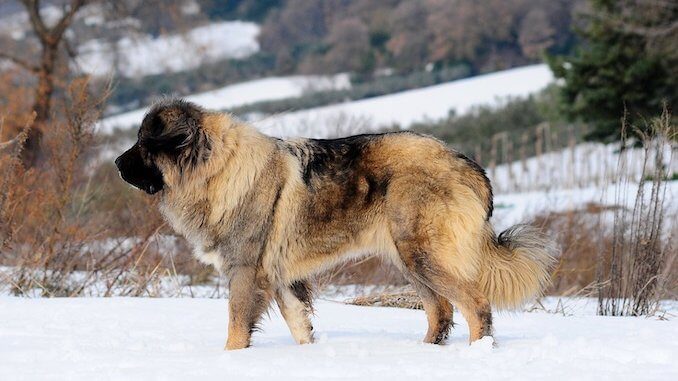
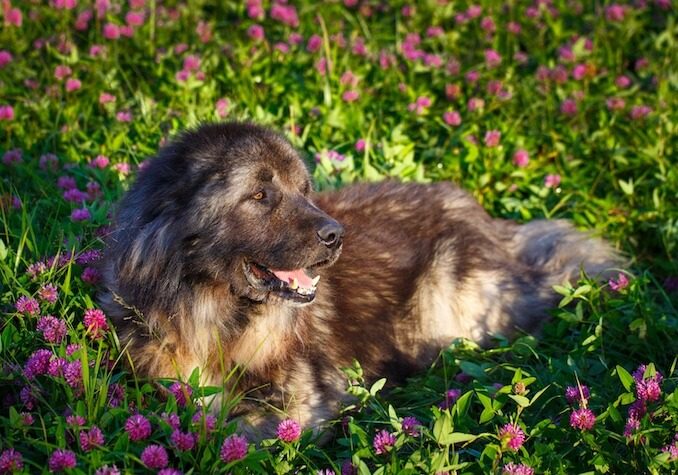
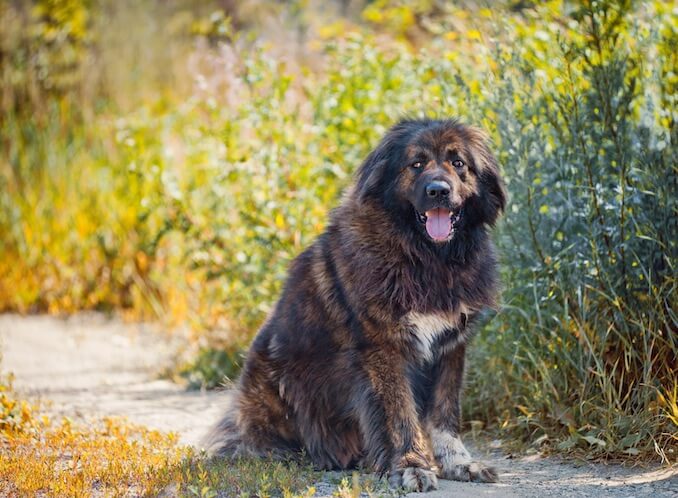
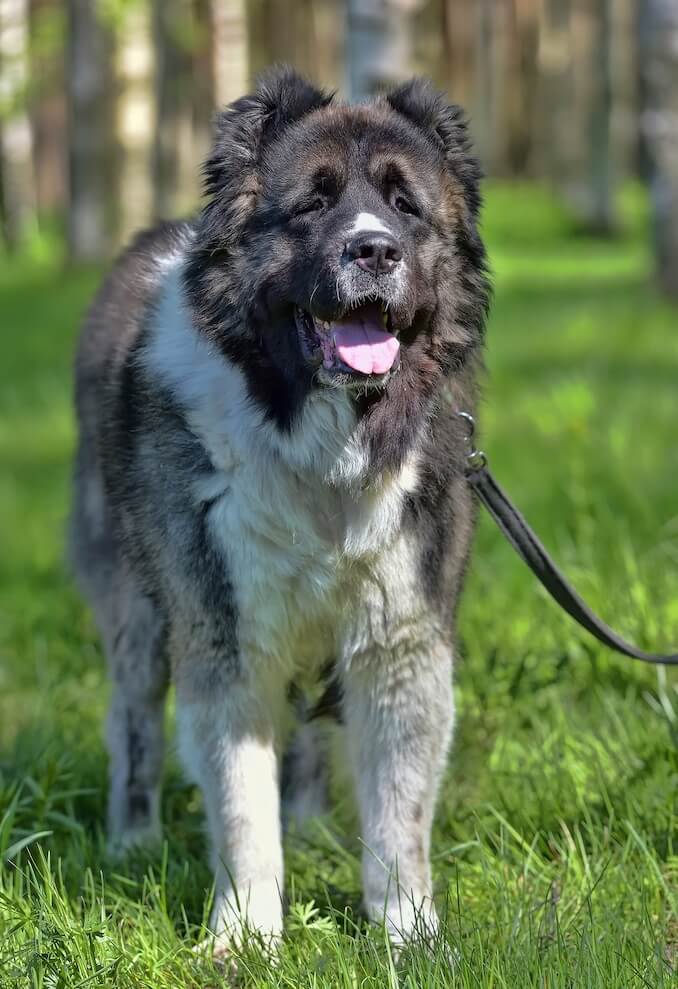
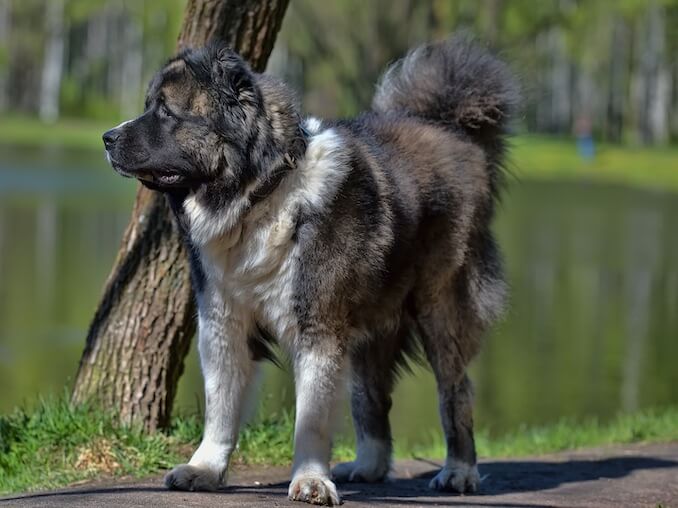
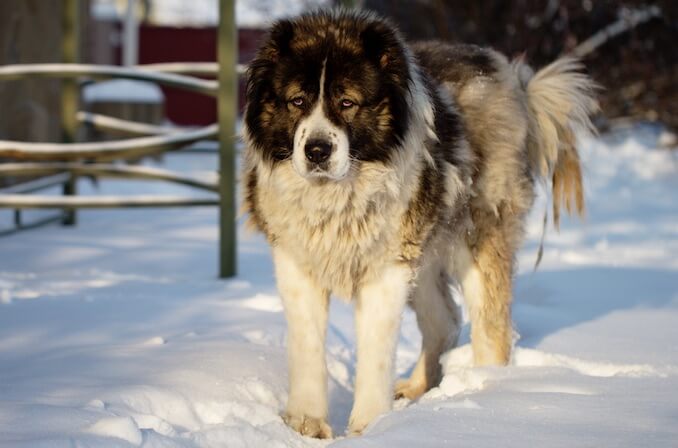

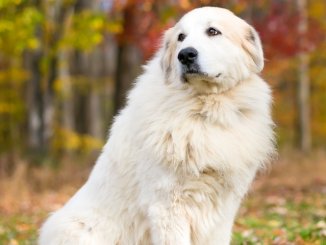
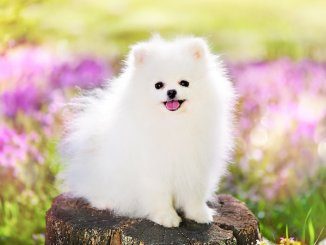

I want one. I’m planning to move outside of the city area. I am looking for a large area. I have a pitbull, as well as 2 small dogs.
I have a Black and Tan German Shepherd, but I would love to own one of these!
I have heard of these a few years back. I have been owned by GSD for the past 60 years and by Bernese Mountain Dogs for the last seven with over 800 acres and raising cattle I would love to have one of the beautiful dogs.
I think they are beautiful. I have two King Shepherds now, one is a short haired, 3 year old male about 115 pounds and stands 24-25 inches tall. I also have a long haired King Shepherd, female, 5 1/2 years old, 82 pounds and stands 22-23 inches tall. Shorter than most shepherds by standards. They are both social with large groups of mixed breed dogs when I take them to a play day. Good protectors, healthy, and spoiled. I would like to know how one of these pups would come into the fold of a household with two adult dogs. This is our second round of Shepherds. The last two were much larger with the male standing 30 inches tall and at 140 pounds. Our female was 26 inches and 96 pounds. My wife and I are used to big dogs and would welcome one of these beauties into our home. I appreciate any feed back.
Thank you,
Steve
I have a 3 year old male his weight is 140 and he is 32 inches high he loves everybody he has never growel at anyone he plays with a little mut that just showed up it is about 10 inches high and has a weight of 12 pounds he will pick him up and tote him around like a cat does a kitten but he dosenot hurt the little dog. He goes to the gate to meet everybody then he is on his way.